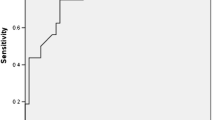Abstract
Background
Acute pancreatitis is an acute inflammatory process of the pancreas with variable involvement of other regional tissues or remote organ systems. Acute fluid collections and pseudocyst formation are the most frequent complications of acute pancreatitis.
Aims
The aims of this study were to evaluate the incidence, risk factors, and clinical course of pancreatic fluid collections and pseudocyst formation following acute pancreatitis.
Methods
A prospective multicenter study was conducted in five participating centers with 302 patients diagnosed with acute pancreatitis from January 2011 to July 2012.
Results
The incidence of pancreatic fluid collections and pseudocyst was 42.7 and 6.3 %, respectively. Patients with fluid collections were significantly younger, compared to those without fluid collections (51.5 ± 15.9 vs. 60.4 ± 16.5 years, P = 0.000). The proportion of alcoholic etiology (54.3 %) in patients with fluid collections was significantly higher compared to other etiologies (P = 0.000). C-reactive protein (CRP) (48 h) was significantly higher in patients with fluid collections, compared to patients without fluid collections (39.2 ± 77.4 vs. 15.1 ± 36.2 mg/dL, P = 0.016). LDH (48 h) was significantly higher in patients with pseudocyst formation, compared to patients with complete resolution (1,317.6 ± 706.4 vs. 478.7 ± 190.5 IU/L, P = 0.000). Pancreatic fluid collections showed spontaneous resolution in 69.8 % (90/129) and 84.2 % of the pseudocysts disappeared or decreased in size during follow up.
Conclusions
Age, CRP (48 h), and alcohol etiology are risk factors for pancreatic fluid collections. LDH (48 h) appears to be a risk factor for pseudocyst formation. Most pseudocysts showed a decrease in size or spontaneous resolution with conservative management.
Similar content being viewed by others
References
Sarr MG. 2012 Revision of the Atlanta classification of acute pancreatitis. Pol Arch Med Wewn. 2013;123:118–124.
Kim CD. Current status of acute pancreatitis in Korea. Korean J Gastroenterol. 2003;42:1–11.
Bradley EL 3rd. A clinically based classification system for acute pancreatitis. Summary of the international symposium on acute pancreatitis, Atlanta, GA, 11–13 September 1992. Arch Surg. 1993;128:586–590.
Diculescu M, Ciocirlan M, Ciocirlan M, Stanescu D, Ciprut T, Marinescu T. Predictive factors for pseudocysts and peripancreatic collections in acute pancreatitis. Rom J Gastroenterol. 2005;14:129–134.
Kourtesis G, Wilson SE, Williams RA. The clinical significance of fluid collections in acute pancreatitis. Am Surg. 1990;56:796–799.
London NJ, Neoptolemos JP, Lavelle J, Bailey I, James D. Serial computed tomography scanning in acute pancreatitis: a prospective study. Gut. 1989;30:397–403.
Lankisch PG, Weber-Dany B, Maisonneuve P, Lowenfels AB. Pancreatic pseudocysts: prognostic factors for their development and their spontaneous resolution in the setting of acute pancreatitis. Pancreatology. 2012;12:85–90.
Maringhini A, Uomo G, Patti R, et al. Pseudocysts in acute nonalcoholic pancreatitis: incidence and natural history. Dig Dis Sci. 1999;44:1669–1673.
Bradley EL, Gonzalez AC, Clements JL Jr. Acute pancreatic pseudocysts: incidence and implications. Ann Surg. 1976;184:734–737.
Kim KO, Kim TN. Acute pancreatic pseudocyst: incidence, risk factors, and clinical outcomes. Pancreas. 2012;41:577–581.
Lankisch PG, Burchard-Reckert S, Petersen M, et al. Etiology and age have only a limited influence on the course of acute pancreatitis. Pancreas. 1996;13:344–349.
Nguyen BL, Thompson JS, Edney JA, Bragg LE, Rikkers LF. Influence of the etiology of pancreatitis on the natural history of pancreatic pseudocysts. Am J Surg. 1991;162:527–530.
Schulze S, Baden H, Brandenhoff P, Larsen T, Burcharth F. Pancreatic pseudocysts during first attack of acute pancreatitis. Scand J Gastroenterol. 1986;21:1221–1223.
Harvey MH, Cates MC, Reber HA. Possible mechanisms of acute pancreatitis induced by ethanol. Am J Surg. 1988;155:49–56.
Chen CC, Wang SS, Chao Y, et al. C-reactive protein and lactate dehydrogenase isoenzymes in the assessment of the prognosis of acute pancreatitis. J Gastroenterol Hepatol. 1992;7:363–366.
Zrnic IK, Milic S, Fisic E, Radic M, Stimac D. [C-reactive protein and lactate dehydrogenase as single prognostic factors of severity in acute pancreatitis]. Lijec Vjesn. 2007;129:1–4.
Neoptolemos JP, Kemppainen EA, Mayer JM, et al. Early prediction of severity in acute pancreatitis by urinary trypsinogen activation peptide: a multicentre study. Lancet. 2000;355:1955–1960.
Mayer AD, McMahon MJ, Bowen M, Cooper EH. C reactive protein: an aid to assessment and monitoring of acute pancreatitis. J Clin Pathol. 1984;37:207–211.
Vitas GJ, Sarr MG. Selected management of pancreatic pseudocysts: operative versus expectant management. Surgery. 1992;111:123–130.
Yeo CJ, Bastidas JA, Lynch-Nyhan A, Fishman EK, Zinner MJ, Cameron JL. The natural history of pancreatic pseudocysts documented by computed tomography. Surg Gynecol Obstet. 1990;170:411–417.
Mehta R, Suvarna D, Sadasivan S, et al. Natural course of asymptomatic pancreatic pseudocyst: a prospective study. Indian J Gastroenterol. 2004;23:140–142.
Soliani P, Ziegler S, Franzini C, et al. The size of pancreatic pseudocyst does not influence the outcome of invasive treatments. Dig Liver Dis. 2004;36:135–140.
Bradley EL, Clements JL Jr, Gonzalez AC. The natural history of pancreatic pseudocysts: a unified concept of management. Am J Surg. 1979;137:135–141.
Floyd A, Pedersen L, Nielsen GL, Thorladcius-Ussing O, Sorensen HT. Secular trends in incidence and 30-day case fatality of acute pancreatitis in North Jutland County, Denmark: a register-based study from 1981–2000. Scand J Gastroenterol. 2002;37:1461–1465.
Gullo L, Migliori M, Olah A, et al. Acute pancreatitis in five European countries: etiology and mortality. Pancreas. 2002;24:223–227.
Mutinga M, Rosenbluth A, Tenner SM, Odze RR, Sica GT, Banks PA. Does mortality occur early or late in acute pancreatitis? Int J Pancreatol. 2000;28:91–95.
Sekimoto M, Takada T, Kawarada Y, et al. JPN Guidelines for the management of acute pancreatitis: epidemiology, etiology, natural history, and outcome predictors in acute pancreatitis. J Hepatobiliary Pancreat Surg. 2006;13:10–24.
Acknowledgments
This work was supported by the 2011 Yeungnam University Research Grant, and the grant of Research Institute of Medical Science, Catholic University of Daegu (2011).
Conflict of interest
None.
Author information
Authors and Affiliations
Corresponding author
Rights and permissions
About this article
Cite this article
Cui, M.L., Kim, K.H., Kim, H.G. et al. Incidence, Risk Factors and Clinical Course of Pancreatic Fluid Collections in Acute Pancreatitis. Dig Dis Sci 59, 1055–1062 (2014). https://doi.org/10.1007/s10620-013-2967-4
Received:
Accepted:
Published:
Issue Date:
DOI: https://doi.org/10.1007/s10620-013-2967-4




